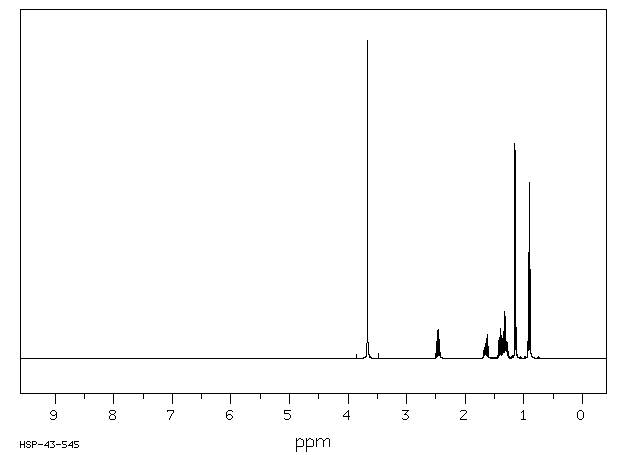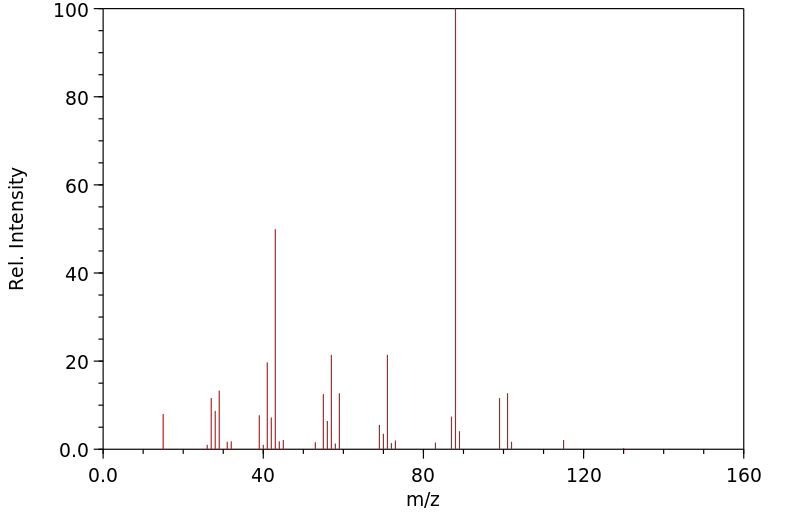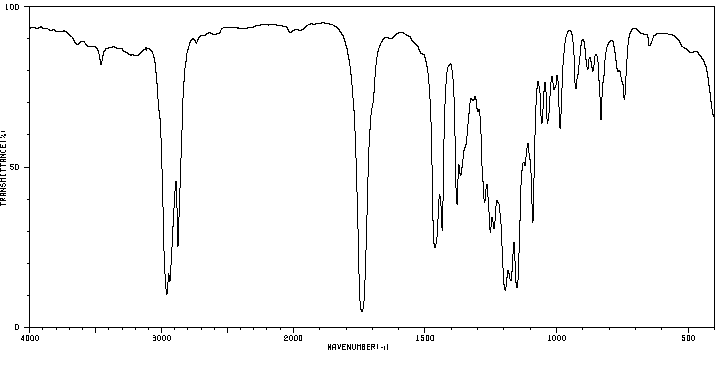2-甲基戊酸甲酯 | 2177-77-7
中文名称
2-甲基戊酸甲酯
中文别名
——
英文名称
methyl 2-methylpentanoate
英文别名
Methyl-2-methylpentanoat
CAS
2177-77-7
化学式
C7H14O2
mdl
——
分子量
130.187
InChiKey
ZTULNMNIVVMLIU-UHFFFAOYSA-N
BEILSTEIN
——
EINECS
——
-
物化性质
-
计算性质
-
ADMET
-
安全信息
-
SDS
-
制备方法与用途
-
上下游信息
-
文献信息
-
表征谱图
-
同类化合物
-
相关功能分类
-
相关结构分类
物化性质
-
沸点:45 °C0.2 mm Hg(lit.)
-
密度:0.878 g/mL at 25 °C(lit.)
-
闪点:85 °F
-
LogP:2.12
-
物理描述:pale yellow liquid
-
折光率:1.400-1.405
-
保留指数:853;853;853;859.3
-
稳定性/保质期:
计算性质
-
辛醇/水分配系数(LogP):2.1
-
重原子数:9
-
可旋转键数:4
-
环数:0.0
-
sp3杂化的碳原子比例:0.86
-
拓扑面积:26.3
-
氢给体数:0
-
氢受体数:2
安全信息
-
危险等级:3
-
安全说明:S16
-
危险类别码:R10
-
WGK Germany:3
-
危险品运输编号:UN 3272 3/PG 3
-
海关编码:2915900090
-
包装等级:III
-
危险类别:3
-
储存条件:储存地点应远离氧化剂,并确保容器密封,存放于干燥、阴凉处。
SDS
SECTION 1: Identification of the substance/mixture and of the company/undertaking
Product identifiers
Product name : Methyl 2-methylpentanoate
REACH No. : A registration number is not available for this substance as the substance
or its uses are exempted from registration, the annual tonnage does not
require a registration or the registration is envisaged for a later
registration deadline.
CAS-No. : 2177-77-7
Relevant identified uses of the substance or mixture and uses advised against
Identified uses : Laboratory chemicals, Manufacture of substances
SECTION 2: Hazards identification
Classification of the substance or mixture
Classification according to Regulation (EC) No 1272/2008
Flammable liquids (Category 3), H226
For the full text of the H-Statements mentioned in this Section, see Section 16.
Classification according to EU Directives 67/548/EEC or 1999/45/EC
R10
For the full text of the R-phrases mentioned in this Section, see Section 16.
Label elements
Labelling according Regulation (EC) No 1272/2008
Pictogram
Signal word Warning
Hazard statement(s)
H226 Flammable liquid and vapour.
Precautionary statement(s) none
Supplemental Hazard none
Statements
Other hazards - none
SECTION 3: Composition/information on ingredients
Substances
Formula : C7H14O2
Molecular Weight : 130,18 g/mol
CAS-No. : 2177-77-7
EC-No. : 218-543-9
No components need to be disclosed according to the applicable regulations.
For the full text of the H-Statements and R-Phrases mentioned in this Section, see Section 16
SECTION 4: First aid measures
Description of first aid measures
General advice
Consult a physician. Show this safety data sheet to the doctor in attendance.
If inhaled
If breathed in, move person into fresh air. If not breathing, give artificial respiration. Consult a physician.
In case of skin contact
Wash off with soap and plenty of water. Consult a physician.
In case of eye contact
Flush eyes with water as a precaution.
If swallowed
Do NOT induce vomiting. Never give anything by mouth to an unconscious person. Rinse mouth with
water. Consult a physician.
Most important symptoms and effects, both acute and delayed
The most important known symptoms and effects are described in the labelling (see section 2.2) and/or in
section 11
Indication of any immediate medical attention and special treatment needed
no data available
SECTION 5: Firefighting measures
Extinguishing media
Suitable extinguishing media
For small (incipient) fires, use media such as "alcohol" foam, dry chemical, or carbon dioxide. For large
fires, apply water from as far as possible. Use very large quantities (flooding) of water applied as a mist or
spray; solid streams of water may be ineffective. Cool all affected containers with flooding quantities of
water.
Special hazards arising from the substance or mixture
Carbon oxides
Advice for firefighters
Wear self contained breathing apparatus for fire fighting if necessary.
Further information
Use water spray to cool unopened containers.
SECTION 6: Accidental release measures
Personal precautions, protective equipment and emergency procedures
Avoid breathing vapours, mist or gas. Remove all sources of ignition. Beware of vapours accumulating to
form explosive concentrations. Vapours can accumulate in low areas.
For personal protection see section 8.
Environmental precautions
Prevent further leakage or spillage if safe to do so. Do not let product enter drains.
Methods and materials for containment and cleaning up
Contain spillage, and then collect with an electrically protected vacuum cleaner or by wet-brushing and
place in container for disposal according to local regulations (see section 13).
Reference to other sections
For disposal see section 13.
SECTION 7: Handling and storage
Precautions for safe handling
Avoid inhalation of vapour or mist.
Keep away from sources of ignition - No smoking.Take measures to prevent the build up of electrostatic
charge.
For precautions see section 2.2.
Conditions for safe storage, including any incompatibilities
Store in cool place. Keep container tightly closed in a dry and well-ventilated place. Containers which are
opened must be carefully resealed and kept upright to prevent leakage.
Specific end use(s)
Apart from the uses mentioned in section 1.2 no other specific uses are stipulated
SECTION 8: Exposure controls/personal protection
Control parameters
Components with workplace control parameters
Exposure controls
Appropriate engineering controls
Handle in accordance with good industrial hygiene and safety practice. Wash hands before breaks and
at the end of workday.
Personal protective equipment
Eye/face protection
Face shield and safety glasses Use equipment for eye protection tested and approved under
appropriate government standards such as NIOSH (US) or EN 166(EU).
Skin protection
Handle with gloves. Gloves must be inspected prior to use. Use proper glove removal technique
(without touching glove's outer surface) to avoid skin contact with this product. Dispose of
contaminated gloves after use in accordance with applicable laws and good laboratory practices.
Wash and dry hands.
The selected protective gloves have to satisfy the specifications of EU Directive 89/686/EEC and
the standard EN 374 derived from it.
Body Protection
impervious clothing, Flame retardant antistatic protective clothing, The type of protective
equipment must be selected according to the concentration and amount of the dangerous
substance at the specific workplace.
Respiratory protection
Where risk assessment shows air-purifying respirators are appropriate use a full-face respirator
with multi-purpose combination (US) or type ABEK (EN 14387) respirator cartridges as a backup
to engineering controls. If the respirator is the sole means of protection, use a full-face supplied air
respirator. Use respirators and components tested and approved under appropriate government
standards such as NIOSH (US) or CEN (EU).
Control of environmental exposure
Prevent further leakage or spillage if safe to do so. Do not let product enter drains.
SECTION 9: Physical and chemical properties
Information on basic physical and chemical properties
a) Appearance Form: liquid
b) Odour no data available
c) Odour Threshold no data available
d) pH no data available
e) Melting point/freezing no data available
point
f) Initial boiling point and 45 °C at 0,3 hPa - lit.
boiling range
g) Flash point 29 °C - closed cup
h) Evapouration rate no data available
i) Flammability (solid, gas) no data available
j) Upper/lower no data available
flammability or
explosive limits
k) Vapour pressure no data available
l) Vapour density no data available
m) Relative density 0,878 g/cm3 at 25 °C
n) Water solubility no data available
o) Partition coefficient: n- no data available
octanol/water
p) Auto-ignition no data available
temperature
q) Decomposition no data available
temperature
r) Viscosity no data available
s) Explosive properties no data available
t) Oxidizing properties no data available
Other safety information
no data available
SECTION 10: Stability and reactivity
Reactivity
no data available
Chemical stability
Stable under recommended storage conditions.
Possibility of hazardous reactions
no data available
Conditions to avoid
Heat, flames and sparks.
Incompatible materials
Strong oxidizing agents
Hazardous decomposition products
Other decomposition products - no data available
In the event of fire: see section 5
SECTION 11: Toxicological information
Information on toxicological effects
Acute toxicity
no data available
Skin corrosion/irritation
no data available
Serious eye damage/eye irritation
no data available
Respiratory or skin sensitisation
no data available
Germ cell mutagenicity
no data available
Carcinogenicity
IARC: No component of this product present at levels greater than or equal to 0.1% is identified as
probable, possible or confirmed human carcinogen by IARC.
Reproductive toxicity
no data available
Specific target organ toxicity - single exposure
no data available
Specific target organ toxicity - repeated exposure
no data available
Aspiration hazard
no data available
Additional Information
RTECS: Not available
To the best of our knowledge, the chemical, physical, and toxicological properties have not been
thoroughly investigated.
SECTION 12: Ecological information
Toxicity
no data available
Persistence and degradability
no data available
Bioaccumulative potential
no data available
Mobility in soil
no data available
Results of PBT and vPvB assessment
PBT/vPvB assessment not available as chemical safety assessment not required/not conducted
Other adverse effects
no data available
SECTION 13: Disposal considerations
Waste treatment methods
Product
Burn in a chemical incinerator equipped with an afterburner and scrubber but exert extra care in igniting
as this material is highly flammable. Offer surplus and non-recyclable solutions to a licensed disposal
company. Contact a licensed professional waste disposal service to dispose of this material.
Contaminated packaging
Dispose of as unused product.
SECTION 14: Transport information
UN number
ADR/RID: 3272 IMDG: 3272 IATA: 3272
UN proper shipping name
ADR/RID: ESTERS, N.O.S. (Methyl 2-methylvalerate)
IMDG: ESTERS, N.O.S. (Methyl 2-methylvalerate)
IATA: Esters, n.o.s. (Methyl 2-methylvalerate)
Transport hazard class(es)
ADR/RID: 3 IMDG: 3 IATA: 3
Packaging group
ADR/RID: III IMDG: III IATA: III
Environmental hazards
ADR/RID: no IMDG Marine pollutant: no IATA: no
Special precautions for user
no data available
SECTION 15 - REGULATORY INFORMATION
N/A
SECTION 16 - ADDITIONAL INFORMATION
N/A
制备方法与用途
毒性
GRAS(FEMA)。
使用限量- 软糖、凝胶制品、布丁、无醇饮料、含醇饮料、糖果、糖霜、坚果制品:0.25 mg/kg
- 冷冻乳品、小吃食品、硬糖:0.5 mg/kg
- 胶姆糖:1.0 mg/kg
上下游信息
-
上游原料
中文名称 英文名称 CAS号 化学式 分子量 2-甲基戊酸 2-Methylpentanoic acid 97-61-0 C6H12O2 116.16 —— methyl 2-methyl-4-pentenoate 20459-96-5 C7H12O2 128.171 -
下游产品
中文名称 英文名称 CAS号 化学式 分子量 —— methyl ester of/the/ (-)(R)-methylpropylacetic acid 151409-52-8 C7H14O2 130.187 —— methyl ester of/the/ (+)(S)-methylpropylacetic acid 151409-53-9 C7H14O2 130.187 2-甲基戊酸 2-Methylpentanoic acid 97-61-0 C6H12O2 116.16
反应信息
-
作为反应物:描述:2-甲基戊酸甲酯 在 三氟乙酸 、 lithium diisopropyl amide 作用下, 以 四氢呋喃 、 二氯甲烷 为溶剂, 反应 54.0h, 生成 2-methyl-2-propylsuccinic acid 1-methyl ester参考文献:名称:发现4-取代的吡咯烷酮丁酰胺作为具有显着抗癫痫活性的新药物。摘要:(S)-α-乙基-2-氧代吡咯烷乙酰胺2(左乙拉西坦,Keppra,UCB SA)是吡乙酰胺的结构类似物,最近已被批准作为成人难治性部分发作的附加治疗药物。由于独特的作用机理,该药物似乎具有显着的功效和高耐受性。后者涉及2的脑特异性结合位点(左乙拉西坦结合位点为LBS),可能在其抗癫痫特性中起主要作用。使用这种新型分子靶标,我们启动了一项药物发现计划,以寻找对LBS具有显着亲和力的配体,以表征其在癫痫和其他中枢神经系统疾病中的治疗潜力。我们系统地研究了吡咯烷酮乙酰胺支架的各个位置。我们发现(i)2上的羧酰胺部分对于亲和力是必不可少的;(ii)在100个不同的侧链中,优选的羧酰胺取代α是具有(S)-构型的乙基;(iii)2-氧吡咯烷环优于哌啶类似物或无环化合物;(iv)内酰胺环的3或5位取代降低了LBS亲和力;(v)内酰胺环被小的疏水基团4-取代改善了体外和体内的效力。已显示在4位上取代的6种有趣的候选物在体内比2种更有效。DOI:10.1021/jm030913e
-
作为产物:描述:2-甲基戊醛 在 1,4-dithio-D,L-threitol 、 recombinant aldehyde dehydrogenase from bovine lens 、 water‐forming NADH oxidase from Streptococcus mutans 、 β-烟酰胺腺嘌呤二核苷酸 作用下, 以 甲醇 、 aq. phosphate buffer 、 乙酸乙酯 为溶剂, 反应 25.0h, 生成 2-甲基戊酸甲酯参考文献:名称:醛化学选择性有氧氧化成羧酸的生物催化方法摘要:在此,我们提出了一项使用三种重组醛脱氢酶(ALDH)将醛氧化为羧酸的研究。ALDH 以纯化形式与烟酰胺氧化酶 (NOx) 一起使用,该酶以双氧(大气压下的空气)为代价回收催化 NAD + 。为了更方便的实际应用,还使用冻干全细胞和静息细胞生物催化剂研究了该反应。优化的生物催化氧化在 pH 8.5 和 40 °C 的磷酸盐缓冲液中运行。从一组 61 种脂肪族、芳基脂肪族、苄基、杂芳族和双环醛中,其中 50 种以较高的产率转化(高达 >99%)。少数邻位取代的苯甲醛、双环杂芳醛和2-苯基丙醛除外。在所有情况下,预期的羧酸都是唯一的产物(>99% 化学选择性)。同一分子内的其他可氧化官能团(例如羟基、烯烃和杂芳族氮或硫原子)保持不变。该反应规模用于氧化 5-(羟甲基)糠醛 (2 g)(一种生物基原料),得到 5-(羟甲基)糠酸,分离收率为 61%。新的生物催化方法避免使用有毒或不安全的氧化剂、强DOI:10.1039/c8gc01381k
文献信息
-
Compounds And Compositions for the Treatment of Ocular Disorders申请人:Graybug Vision, Inc.公开号:US20170080092A1公开(公告)日:2017-03-23The disclosure describes prodrugs and derivatives of prostaglandins, carbonic anhydrase inhibitors, kinase inhibitors, beta-adrenergic receptor antagonists and other drugs, as well as controlled delivery formulations containing such prodrugs and derivatives, for the treatment of ocular disorders.
-
PROCESS FOR MAKING AND USING HOF.RCN申请人:Murray Christopher公开号:US20110040092A1公开(公告)日:2011-02-17The invention relates to a process for making HOF.RCN and using it to oxidise organic substrates in a quick and safe way. The process comprises passing diluted fluorine through a conduit and RCN in water through another conduit into a microreactor to form HOF.RCN and reacting this with an organic substrates.
-
TOLL LIKE RECEPTOR MODULATOR COMPOUNDS申请人:Gilead Sciences, Inc.公开号:US20160289229A1公开(公告)日:2016-10-06The present disclosure relates generally to toll like receptor modulator compounds, such as diamino pyrido[3,2 D]pyrimidine compounds and pharmaceutical compositions which, among other things, modulate toll-like receptors (e.g. TLR-8), and methods of making and using them.
-
Hydrogenation of Esters by Manganese Catalysts作者:Xiao‐Gen Li、Fu Li、Yue Xu、Li‐Jun Xiao、Jian‐Hua Xie、Qi‐Lin ZhouDOI:10.1002/adsc.202101376日期:2022.2.15The hydrogenation of esters catalyzed by a manganese complex of phosphine-aminopyridine ligand was developed. Using this protocol, a variety of (hetero)aromatic and aliphatic carboxylates including biomass-derived esters and lactones were hydrogenated to primary alcohols with 63–98% yields. The manganese catalyst was found to be active for the hydrogenation of methyl benzoate, providing benzyl alcohol
-
The scope and mechanism of palladium-catalysed Markovnikov alkoxycarbonylation of alkenes作者:Haoquan Li、Kaiwu Dong、Haijun Jiao、Helfried Neumann、Ralf Jackstell、Matthias BellerDOI:10.1038/nchem.2586日期:2016.1270 years, numerous catalyst systems have been developed that allow for highly linear-selective (anti-Markovnikov) reactions and are used in industry to produce linear carboxylates starting from olefins. In contrast, a general catalyst system for Markovnikov-selective alkoxycarbonylation of aliphatic olefins remains unknown. In this paper, we show that a specific palladium catalyst system consisting
表征谱图
-
氢谱1HNMR
-
质谱MS
-
碳谱13CNMR
-
红外IR
-
拉曼Raman
-
峰位数据
-
峰位匹配
-
表征信息
同类化合物
(±)17,18-二HETE
(±)-辛酰肉碱氯化物
(Z)-5-辛烯甲酯
(Z)-4-辛烯酸
(R)-甲羟戊酸锂盐
(R)-普鲁前列素,游离酸
(R,R)-半乳糖苷
(E)-4-庚烯酸
(E)-4-壬烯酸
(E)-4-十一烯酸
(9Z,12E)-十八烷二烯酸甲酯
(6E)-8-甲基--6-壬烯酸甲基酯-d3
(3R,6S)-rel-8-[2-(3-呋喃基)-1,3-二氧戊环-2-基]-3-羟基-2,6-二甲基-4-辛酮
龙胆二糖
黑曲霉二糖
黄质霉素
麦芽酮糖一水合物
麦芽糖醇
麦芽糖酸
麦芽糖基蔗糖
麦芽糖一水合物
麦芽糖
鳄梨油酸乙酯
鲸蜡醇蓖麻油酸酯
鲸蜡醇油酸酯
鲸蜡硬脂醇硬脂酸酯
鲸蜡烯酸脂
鲸蜡基花生醇
鲫鱼酸
鲁比前列素
鲁比前列素
高级烷基C16-18-醇
高甲羟戊酸
高效氯氰菊酯
高-gamma-亚油酸
马来酸烯丙酯
马来酸氢异丙酯
马来酸氢异丁酯
马来酸氢丙酯
马来酸氢1-[2-(2-羟基乙氧基)乙基]酯
马来酸单乙酯
马来酸单丁酯
马来酸二辛酯
马来酸二癸酯
马来酸二甲酯
马来酸二烯丙酯
马来酸二正丙酯
马来酸二戊基酯
马来酸二异壬酯
马来酸二异丙酯










